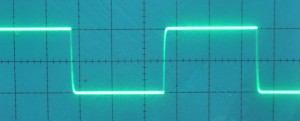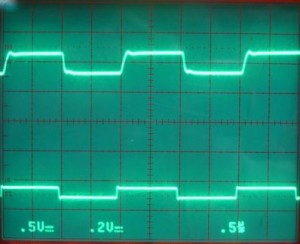Fiber and Wireless Explained
In a recent blog post for Innovation Files, I covered some claims that various advocates make for fiber optic networks about sharing and symmetry that are completely incorrect. I’d like to dig a little deeper to explain the actual benefits and shortcomings of fiber.
The bandwidth (number of bits per second that can be successfully received) of any network is a function of the ratio of signal to noise. Bits are transmitted through a network by impressing a pattern on the network at the source, and they’re received by decoding this pattern at the other end of the wire or wireless network.
The engineering problem with the transmission of information through a network is that the pattern degrades with distance. The transmitter may be sending a pattern that looks very crisp, like this square wave:
But at the receiving end the wave will look something like these two waves:
The receiver has to process the incoming wave in order to see it as it looked at the outgoing end of the network. The shape of the wave – the “wave form” – is altered by several different forces along the way. The signal naturally loses coherence with distance because energy radiates or spreads. This is especially troublesome for wireless systems, and is only partially controlled by directional antennas.
The signal also echoes as it moves through the network and essentially interferes with itself. That’s where the harmonics come in, they’re multiples of the basic frequency of the wave.
And the signal combines or “couples” with electromagnetic energy in the environment. Random noise at the same phase as the signal (where the signal goes up, the noise also goes up) increases the strength of the received signal, but noise at the opposite phase decreases it.
Protecting the signal from the corrupting influence of noise is done in several ways. The coaxial cable used by cable TV has a foil shield and a wire braid that protect the signal from environmental noise. The shield reflects noise, and the braid conducts it along a path outside the signal. The coax signal radiates around the solid copper wire at the center of the cable, and the shield and braid are outside this area.
Telephone wire is twisted every few inches to create a stronger magnetic field, which reduces the conductivity of the wire as far as environmental noise is concerned, but it’s more vulnerable to environmental noise from transformers and the Earth’s magnetic field than coax.
Wireless signals can’t be shielded, of course, so they obtain noise immunity by using patterns that aren’t typically found in the environment. This is clever, but it only goes so far. In practice, DSL and cable systems use patterns (called “modulation and coding systems”) that originated in radio systems, such as OFDM.
Fiber isn’t very picky about modulation because its signal is more easily protected from environmental noise than the other networks. Fiber transmits light, so protecting it from noise is mainly a matter of blocking light from the outside and containing the light inside the cable. This is no more difficult than pulling the blinds on a window.
You can see how noise immunity works by taking a flashlight into a closet when the sun’s up: close the door and turn on the flashlight and you see a bright pattern. Go outdoors and shine the light in a wall that’s bathed in direct sunlight, and your pattern won’t be nearly so bright. You can simulate a fiber optic system by flashing the light on and off. At a certain rate of speed, you won’t be able to count the flashes outdoors, but you’ll be able to count them well above that rate in the dark room. Counting the flashes is akin to what the receiver does.
So the bottom line is that fiber optics allow a signal to be decoded at a higher speed over the same distance as copper wire or radio do. The only essential difference between copper and fiber is noise immunity.
Between fiber and wireless there are two essential differences, noise immunity and mobility; this is a more complex tradeoff, since each system has an advantage over the other.
Moving down the list, it’s also the case that fiber is more reliable than copper. This doesn’t get discussed as much, but it’s important over the lifetime of a network. Consider the impact of wind and water on wires. Fiber cable is smaller and lighter than copper, especially coax, so it’s less sensitive to the effects of wind and less likely to oscillate in poles in high wind. Because fiber is so inherently light, it’s manufactured in bundles and wrapped in material that strengthens it. So it has a better ratio of strength to weight.
Fiber optic cable is also insensitive to water damage, even salt water damage. When the electricity in a copper wire comes in contact with water because an insulator is damaged, it is conducted by the water (especially true for salt water) and transformed into heat. This can increase current on the cable and cause it to melt. If you drown a fiber cable in water, the signal may degrade a little, but you won’t damage the cable (this is not entirely true for cladded cable, but that’s a different story.) Similarly, underwater antennas are possible, but they’re less efficient than dry land antennas.
If we were building our very first networks today, we would build them out of radios and fiber optics. The radios would be attractive because of mobility and cost: one cellular radio tower can serve 1000 users at a fraction of the cost of cable installation, and microwave radios can also be used to cover long distances between towers. The “m” in MCI stood for microwave, as you may know. MCI built a nationwide long-distance network on microwave radio technology. At some point, however, we would exhaust the capacity of microwave and turn to fiber. Then we would make a long series of tradeoffs between fiber and radio as demands for bandwidth and mobility evolved.
A similar set of tradeoffs are made every day in the real world, with copper wire in the mix. The virtue of copper is simply the fact that it’s already installed and already goes just about everywhere, while fiber is concentrated around switching centers where it’s most necessary. As time goes by, more and more copper is retired in favor of fiber and wireless. Fiber replaces copper from the inside the network (around the switching centers) and wireless replaces it from the outside of the network (around the user.)
The dynamics that motivate copper replacement by these two other technologies are relentless as matter of engineering and economics. If we try to speed them up by subsidy or regulation, the benefit will be hard to quantify, but if they’re retarded, we’ll notice a difference. More on that in another post.






Good to see you agree that not all modes are created equal.
BTW, I coined the law of wireless gravity which holds a wireless bit will seek out fiber as quickly and cheaply as possible. It was out there like the laws around network effect (Metcalfe), processing scale (Moore), mobility (McGquire), and congestion/concentration (Zipf), so I thought I would take it. But I am not a narcissist and hold to wiki principles.
The law of wireless gravity recognizes the differences in modes, bandwidth, throughput, latency, use context, etc… And it is driven by business models as much as by technology and proven competitive network precepts. Not BS monopoly policy and various other obfuscations!
That’s very special, Michael, I’m happy for you.